Developing picture ideas
First of all, the good news: No , you don't always need a sophisticated image idea to take a remarkable photo. It is also possible to take a picture without a (previous) picture idea, without a concept.
Figure 5.1: "Just" a beautiful portrait. Taken spontaneously; without a concept. Nikon D4 with 2.8/105mm micro Nikkor. 1/160 second, Blender 8, ISO 100.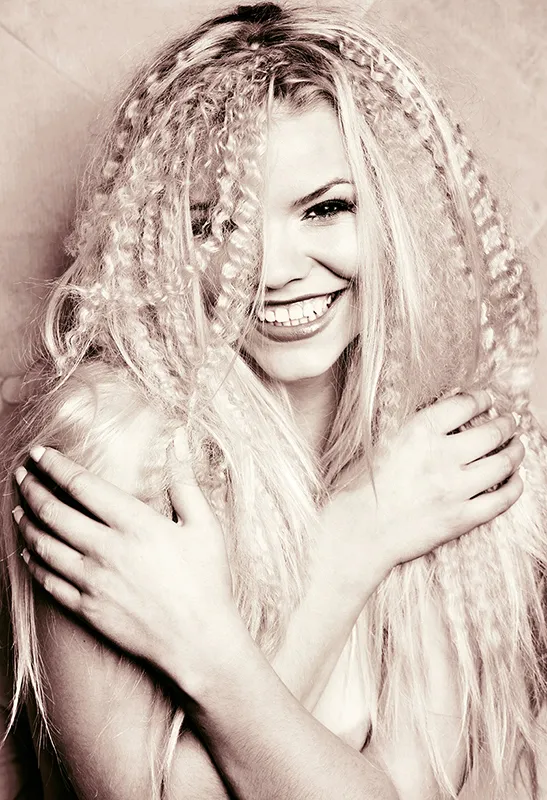
(Photo © 2013: Jens Brüggemann - www.jensbrueggemann.de)
However: Having an image idea helps immensely. Most photographers find it much easier when they are given a task that acts as a kind of image idea and gives them guidelines that they can use as a starting point for the photo shoot.
Since I realized this, about 5 years ago, I have been giving the participants daily assignments during my one-week photo workshops abroad. These are designed to help them get an easier, quicker approach to shooting. And although following the daily task is voluntary, almost all participants always take part. This shows how much more pleasant it is for us photographers to work with Bildidee.
Note: Some photographers literally copy photos 1:1 (at least they try to); presumably due to a lack of their own image ideas. On the one hand, this is not entirely fair to the original author of the image and on the other hand, the success will probably never be as successful as hoped, because it is extremely difficult to copy a really great image exactly.
There are many reasons for this: A different model is pictured, with a different temperament and different facial expressions; a different photographer is taking the picture; the location is (presumably) different; the make-up will be different; a different lens was probably used and different shooting parameters were set on the camera; in addition, the time of day may have been different and therefore also the lighting situation; the shooting distance, height and camera position will also have been different.
In short, there are a thousand reasons why the recreated photo will never be as good as the original. In this respect, it's better to do your own thing, come up with your own idea for a picture or, if you prefer, just go for it. Anything is better and more satisfying than copying the artwork of other photographers!
5.1 Photographing without a concrete image idea
Sometimes it's easier to take a picture without any idea at all before you start thinking about it. There are moments when you should simply get started instead of hesitating.
Figure 5.2: It is often enough to photograph a pretty model (lightly dressed) in front of an exotic background. I, at least, don't miss any unusual ideas in this photo. Sometimes it's enough if a photo is just nice to look at. Nikon D3X with 2.8/14-24mm Nikkor. 1/250 second, Blender 20, ISO 100.
(Photo © 2011: Jens Brüggemann - www.jensbrueggemann.de)
5.2 Self-imposed tasks
Nothing is more unpleasant than the beginning of a photo shoot, when the photographer asks the model to stand in front of the background and then reaches for the camera and then - all of a sudden - doesn't know how to start ...
The situation is unpleasant because the model is waiting and thinks you have ideas, after all, the person with the camera in their hand is the artist ...!
If you want to avoid such situations, you simply have to set yourself a task before the shoot. In the absence of a concrete image idea, this will at least help you to get started with the photo shoot.
For example, the photographer can decide to only shoot in black and white. Or, as I often do, choose a specific focal length to shoot with exclusively during the photo shoot. The advantage of concentrating on a single (fixed) focal length is that you can really focus on the creative possibilities of this focal length.
Another self-imposed task could be that the photographer decides to use a certain accessory (for now) for all photos (for example, a mirror through which the model is photographed).
Note: The self-assigned tasks are the preliminary stage to the image idea. They help the photographer to find an introduction to the photo shoot.
Figure 5.3: At Photokina 2008, where I was commissioned by Nikon to hold a few live photo shoots with models on stage, I was given a completely free hand in developing the concept (the image idea). Only the budget was specified. But what I would do with it was entirely up to me. I finally decided to create a futuristic scene. After all, Photokina and the presentation of new cameras was all about technological innovations.
I created the futuristic scene with appropriate lights in the background (with colored illuminated supply hoses). The styling, clothing and props were also coordinated with the image idea. Finally, artificial fog was used to give the impression of science fiction films and also to make the lights visible, because light alone is invisible; it needs particles in the air to reflect it.
In this way, I continued to develop the "futuristic scene" task into a concrete image idea. Nikon D3 with 2.8/105mm micro Nikkor. 1/100 second, Blender 4, ISO 1000.
(Photo © 2008: Jens Brüggemann - www.jensbrueggemann.de)
5.3 Being inspired by the environment
We are all "products" of our environment. What we see, feel, hear, smell etc. has an influence on us. Since we photographers are more "visually" inclined, we should get into the habit of walking through the world with our eyes open, if we are not already doing so.
Being inspired by our surroundings means that we are bombarded with all kinds of sensory impressions, which we can then process into something new and, ideally, turn into an image idea.
Even if there are only a few fragments that are processed, the origin of many pictorial ideas lies in what we consciously or unconsciously perceive (for example when strolling through the streets and through nature). In my opinion, however, this only works if you allow the environment to have an effect on you without stress and hectic.
Figure 5.4: For Nikon Solutions 2012, which took place in Essen, I had to think of several image ideas for the live photo shoots I was doing. I walked through the streets and through the stores; including a gothic store, because that's where I had seen the classy-looking lace-trimmed black skirt months before. This time I also discovered the bolero pictured here and a Schick creepy (decorative) coffin.
That's how I came up with the idea of a "vampire shoot". I bought other suitable props (vampire teeth, Stocker, skull, stick-on wall, ...) in Düsseldorf in a store for carnival articles, which is open all year round. Nikon D4 with 2.8/24-70mm Nikkor. 1/125 second, Blender 8, ISO 100.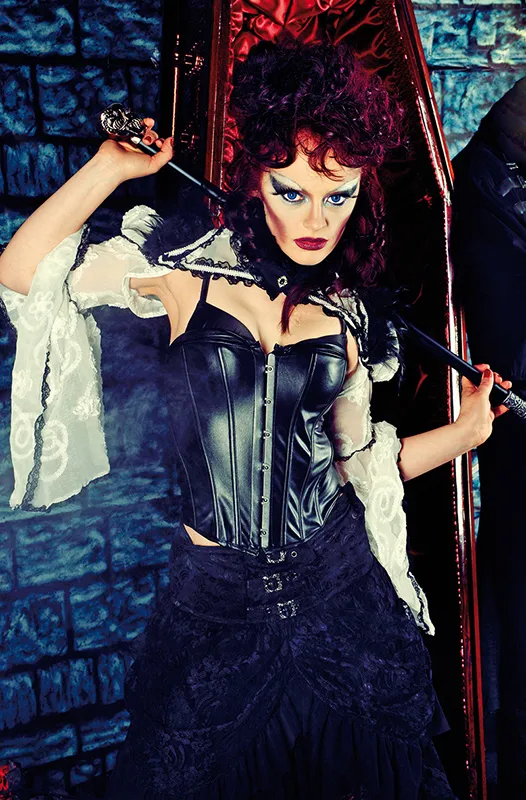
(Photo © 2012: Jens Brüggemann - www.jensbrueggemann.de)
5.4 Taking inspiration from the model
It is perfectly legitimate for a model photographer to plunge into a photo shoot unprepared in order to be inspired by the model herself. Only intensive collaboration opens up new perspectives and enables extraordinary photos, away from the mainstream.
After all, we don't just photograph models - we also photograph "individuals", personalities. And that's why the photographer first has to find an approach to the model in order to be able to take photos that are more than just depictions of her outward appearance. But you can't plan something like that. It has to happen (with good, trusting cooperation).
Figure 5.5: I've photographed Kim quite a few times now. But our first photo shoot resulted in photos full of power and intensity that I still enjoy looking at today. Our shoot was actually already over at the time. But I suggested we do some more free work with her that was less stiff and a bit more relaxed and "crazy".
And that's how this series came about, for which I turned my music system up full blast. I could only give instructions by hand signal, but the good mood infected us both and the results (more photos from this series can be found in my book "Modelfotografie", 2013, mitp-Verlag) are still inspiring. Nikon D3X with 2.8/105mm micro Nikkor. 1/125 second, Blender 10, ISO 100.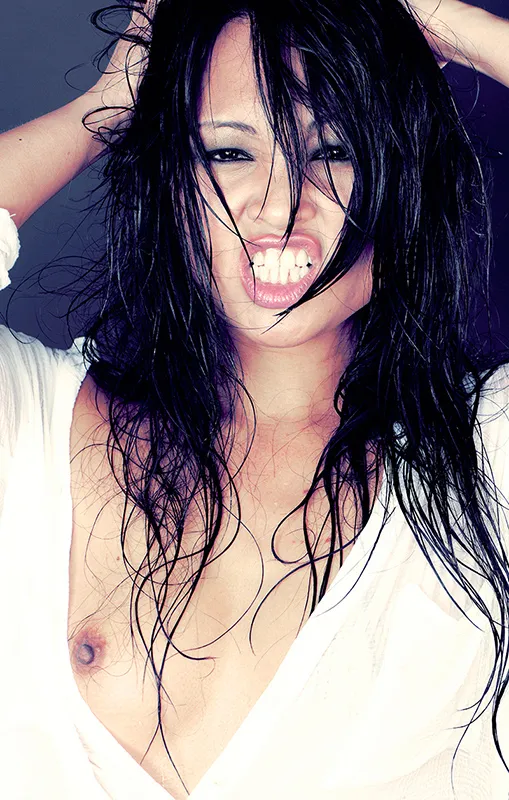
(Photo © 2010: Jens Brüggemann - www.jensbrueggemann.de)
Commissioned shoots
In commissioned photo shoots, the client usually provides the image idea. This is practical because the client has already given the photographer a task. Often, however, the photographer still has to think in detail about the exact implementation and design.
In the past 15 years of my self-employment as a photographer, I have received assignments with completely different levels of detail. Sometimes only the theme was specified (for example, photographing calendar motifs for the coming year) and sometimes it went as far as a detailed specification in the form of a layout, which was to be photographed identically. (Fortunately, the latter only happens very rarely for me, maybe once every 2 years. These are photo shoots that are no fun and deadly boring. I simply need my (artistic) freedom).
Figure 5.6: If the client is present at the photo shoot, this actually only has advantages, because as a photographer I can always consult with him and have him approve my realization.
This is particularly advantageous with modern image design, because I may not even know beforehand whether the client shares and approves of my point of view. This way I can be sure that the customer will be satisfied with the results later on. The presence of the client also has the advantage that it will be difficult for them to complain about the photo results afterwards. Any Richter (should it come to a legal dispute) will rightly say that the presence of the customer also obliges him to direct the photo shoot according to his ideas.
Nikon D3S with 2.8/105mm Micro Nikkor. 1/200 second, Blender 5, ISO 640.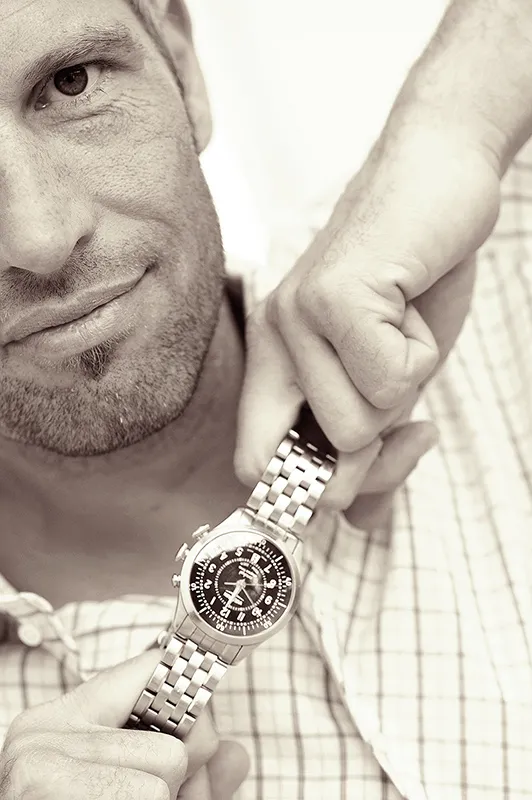
(Photo © 2011: Jens Brüggemann - www.jensbrueggemann.de)
5.6 Developing the image idea together with the model
In the preliminary meeting (which should preferably take place a few days before the photo shoot), the model and photographer not only get to know each other (if they have not worked together before), but also clarify the photographic direction (for example, whether fashion, beauty or erotic photos are to be taken). Once the model and photographer have agreed on a certain type of shot, the image idea can be developed together. This has the advantage that the model also identifies with the photos. The model will then be more motivated to complete the shoot than would be the case if the photographer alone determines the image idea.
It is important that the brainstorming is as creative and informal as possible. Both sides should give free rein to their spontaneous thoughts in the brainstorming session - without checking the feasibility at this stage. In the first step, only flashes of ideas are written down (collected). Only then are the ideas discussed and later checked for feasibility.
Even picture ideas that seem far-fetched should be collected at the beginning. Who knows whether there might be an opportunity to realize them later.
Once an image idea has been found that can be realized (even under the given financial restrictions), planning can begin regarding the purchase of props, the rental of a suitable location, etc.
Note: If the model has been involved in the brainstorming process right from the start and identifies with the image idea, they will be much more enthusiastic and committed to the shoot!
By brainstorming, you not only use your own creative potential, but also that of at least one other (second) person. If you also assume that this approach creates synergy effects, it becomes clear that involving the model in brainstorming is highly recommended from a creative-photographic point of view!
Figure 5.7: Image ideas often arise when the model's hobbies are used as a starting point.
The advantage of this is that people feel comfortable in connection with their hobbies and act more confidently in front of the camera (or are simply more relaxed than in a photo studio, for example). This applies to child models and adults alike. Nikon D3S with 4/24-120mm Nikkor at a focal length of 98mm. 1/500 second, Blender 4.5, ISO 1000.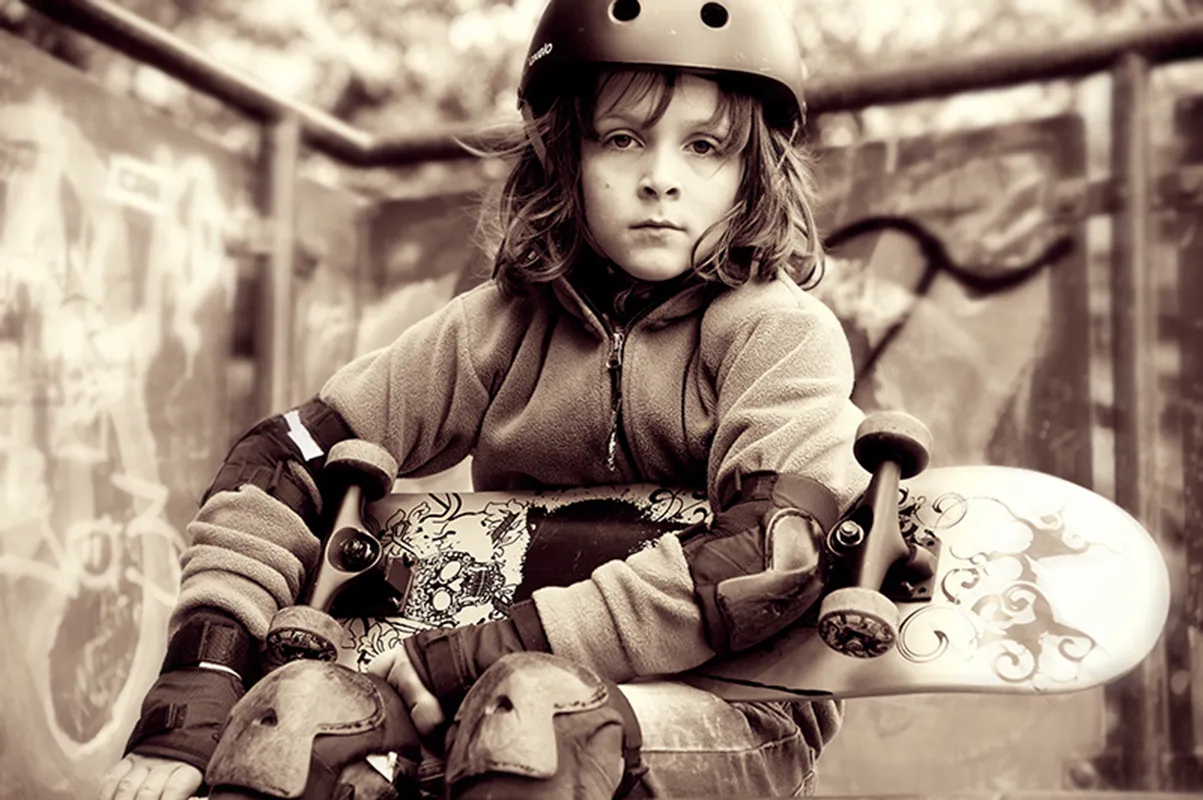
(Photo © 2011: Jens Brüggemann - www.jensbrueggemann.de)
Figure 5.8: Children like to dress up! A picture idea that has this as its theme will therefore always go down well with the youngsters. Nikon D4 with 1.4/85mm Nikkor. 1/160 second, Blender 5.6, ISO 100.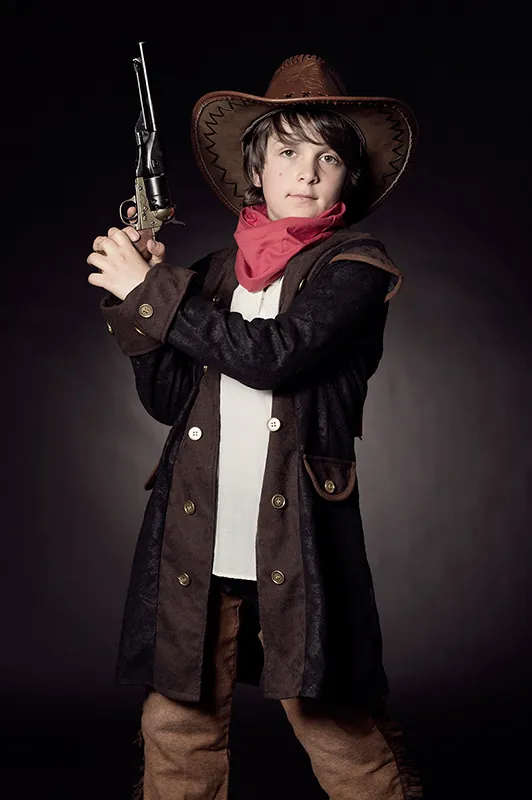
(Photo © 2013: Jens Brüggemann - www.jensbrueggemann.de)
5.7 Use the (lucky) coincidence!
Photographers must not only be creative, but also flexible! This is very important in professional life, because conditions are not always ideal. Things often turn out differently than planned. Only those who are flexible will survive the tough day-to-day work as a photographer. However, it also happens time and again that conditions change, but not always for the worse! (However, every change is initially seen as bad, because it makes an adjustment necessary).
Sometimes coincidences happen which - if the photographer makes use of them - can lead to a new image idea or at least have a major positive influence on the photographic result. So don't always see changes in parameters as a disadvantage; see them as an opportunity! Make the best of it!
Figure 5.9: I actually just wanted to take a few romantic photos of a model in a long white dress in the forest. As the model had brought a nostalgic make-up mirror with her, I had the idea of making it appear in the photo. Accordingly, I then edited the photo differently than originally intended, because I thought that the mirror should be better depicted in an aged-looking gray-brown. I only wanted the actual photo of the model to appear in color (in desaturated colors). Nikon D4 with 2.8/14-24mm Nikkor. 1/60 second, Blender 8, ISO 100.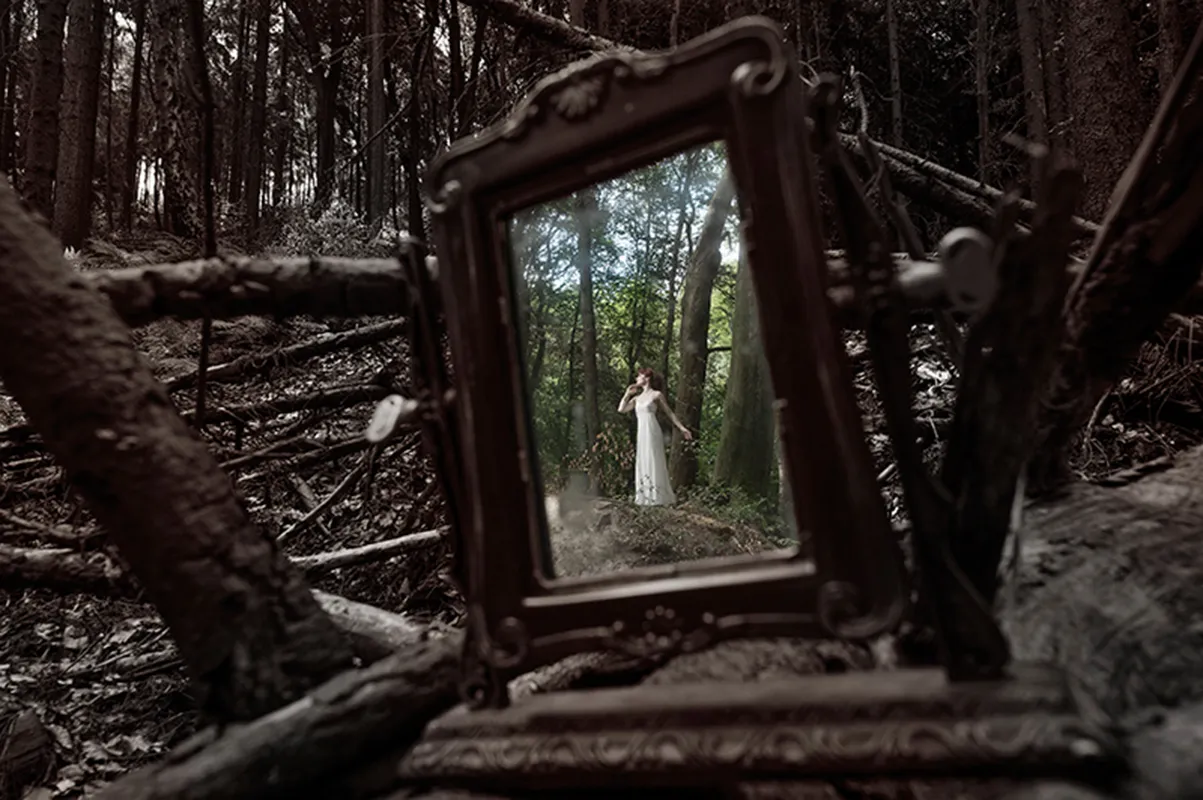
(Photo © 2013: Jens Brüggemann - www.jensbrueggemann.de)
Figure 5.10: The model was two hours late for this photo shoot! I almost didn't feel like it anymore; the sky was also closing in. However, I hadn't planned for clouds; I wanted to take photos with a bright blue sky. Reluctantly, I took a few photos after all. But after I changed my concept and the clouds and the threatening-looking sky became part of my picture idea, I was delighted with the result. Nikon D3X with 2.8/24-70mm Nikkor at a focal length of 31mm. 1/200 second, Blender 22, ISO 100.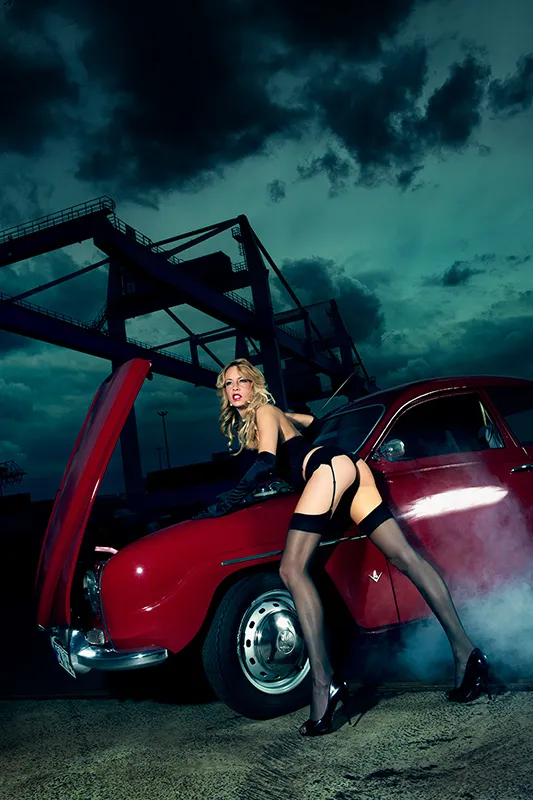
(Photo © 2010: Jens Brüggemann - www.jensbrueggemann.de)
5.8 Every year again ...
It's not very often that the season dictates the picture idea. But Christmas is a particularly good time to take pictures of appropriate motifs.
Figure 5.11: At least as a Christmas greeting for your best friend, such a photo is always suitable ... Nikon D3S with 1.4/85mm Nikkor. 1/160 second, Blender 6.3, ISO 200.
(Photo © 2010: Jens Brüggemann - www.jensbrueggemann.de)
Note: Now that the equipment has been purchased, the model and the location have been found and an image idea has been developed, the next part of this tutorial series is all about the implementation, the photo practice. A few essential image composition tips should help you with model photography.


